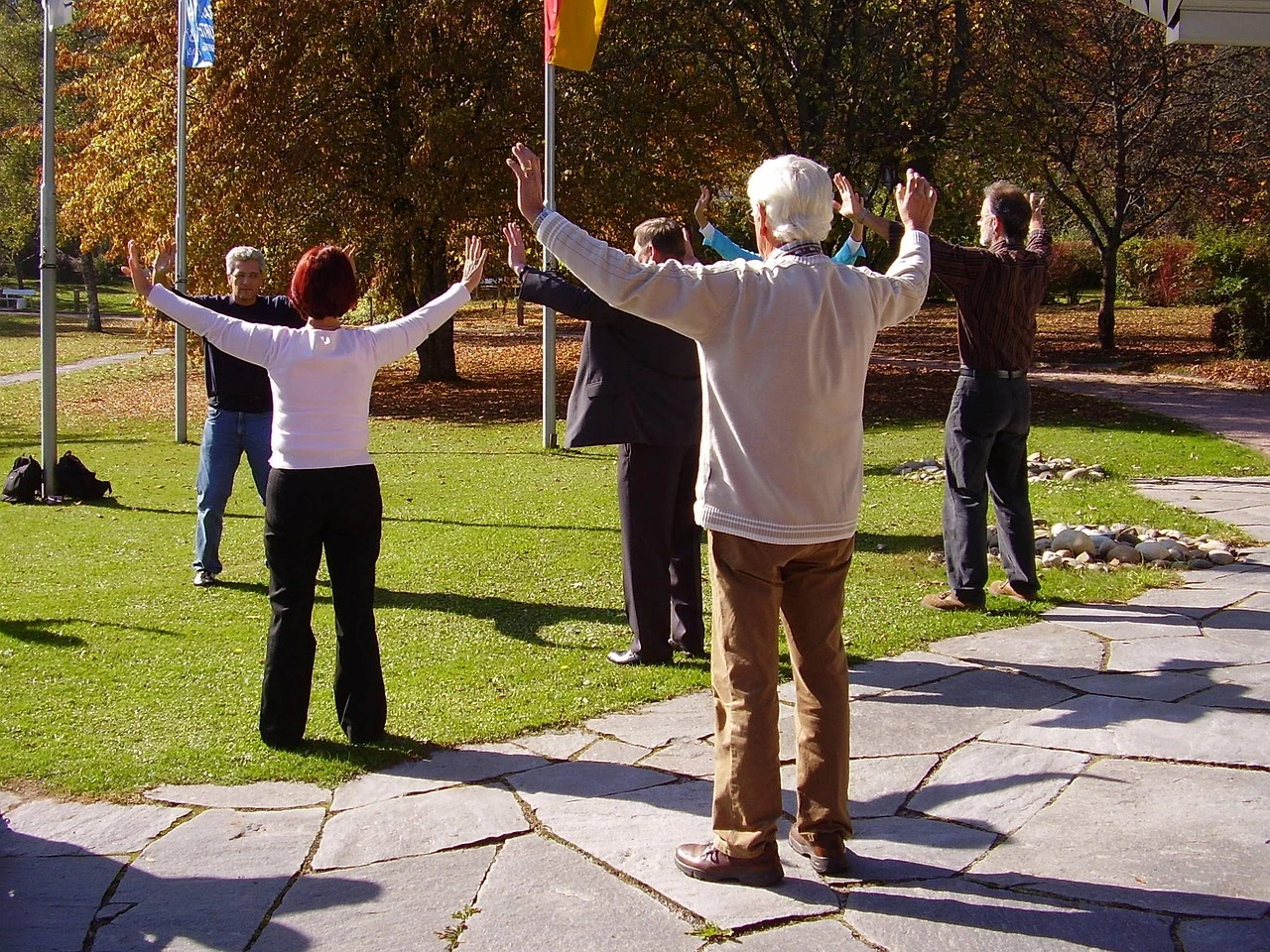This post may contain affiliate links and ads in which we may earn a small percentage of purchases.
Photo Credit: Michael Raab
Table of Contents
We’ve been discussing Tai Chi quite a bit, so let’s delve into Qigong. After reading this article you’ll have a better idea of the benefits and underlying mechanisms used to
What is QiGong?
Many people ask “What is Qigong?” (pronounced “Chee Gong”), or if Tai Chi and Qigong are the same, or if Tai Chi is a type of Qigong exercise. Based on my historical research and personal learning, I can clarify that QiGong is a much older form of breathing exercises and meditation, from which Tai Chi is derived. Tai Chi combines these breathing exercises with martial arts, while Qigong focuses solely on breathing exercises and internal energy work. In fact, Qigong translates to “energy work,” with “Qi” meaning energy and “Gong” meaning work.
Why is Qigong Useful?
Now, why is Qigong useful, how is it applied, and what is its purpose? Everything has a purpose. For example, if you’re on a weight loss program, I usually recommend walking or jogging, or any exercise for 30 minutes. Can Qigong help with weight loss? Yes, it can, although some exercises are more efficient at burning calories. Qigong includes standing meditations where squatting can add a physical exercise component, but it’s not the primary focus. It provides an comprehensive exercises to improve overall mood, well being, and vitality.
A stainless-steel acupuncture pen and gua sha set for massage, reflexology, and tension relief.
 View Product
View Product
Purpose of Qigong
The purpose of Qigong is to build and condition your body to perform necessary activities. It clears the mind, improves circulation, and enhances grip strength—at least from my personal experience. While I need to conduct more research on grip strength specifically, I can say that Qigong provides significant benefits in these areas.
The Benefits of Qigong
These are some of the benefits of Qigong, and that’s why we practice it. Qigong allows us to slow things down and be present. If you think Tai Chi is slow, try doing Qigong stances, such as “Embracing the Tree,” where both feet are planted on the ground, and the shoulders are relaxed. This is known as zhan zhang training. I want to thank those who pointed out that I was using the incorrect name. Another stance is the “Wuji Position,” where the arms are down, the shoulders are relaxed, and you’re still rooted into the ground with slightly bent knees.

Standing in these positions builds strength while promoting relaxation. The beauty of Qigong exercises is that you use strength while relaxing, and you relax while using strength. This unique balance enhances both physical and mental well-being.
One of the benefits of Qigong that I’ve personally experienced is improved grip strength. This is just one example of how Qigong can be beneficial to everyone. Depending on your needs, Qigong can enhance your natural abilities. If you’re more strength-oriented, you might find increased strength. If you’re more focused on agility or mental clarity, you’ll see improvements in those areas as well, alongside better balance.
Research on Qigong
I’ll go more into research in later articles, but we can highlight important findings from the studies. A systematic review of 28 studies showed Qigong “produces positive results on health, mainly in the medium and long term.”1
Conditions that Qigong has been shown to be potentially beneficial for include:2
- Cancer
- Fibromyalgia
- Parkinson’s disease
- Chronic Obstructive Pulmonary Disease (COPD)
- Burnout
- Stress
- Social isolation
- Chronic low back pain
- Cervical pain
- Tinnitus (buzz)
- Osteoarthritis
- Fatigue
- Depression
- Cardiovascular diseases
A 2020 review that included 13 studies of 893 people with mild cognitive impairment suggested that qigong improved cognition and memory after 3 and 6 months of practice.3
A 2008 study found that Qigong could reduce state anxierty, reduce depression and anger, reduce fatigue, improve vitality, and overall relaxation and homeostasis.4
Components of Qigong
Qigong consists of standing postures, arm movements, and rhythmic breathing. These elements are designed to coordinate everything, following the same principles of relaxation and posture as Tai Chi. This involves relaxing the shoulders, letting the weight sink down, and maintaining proper anatomical alignment.
According to the National Center for Complementary and Integrative Health (NCCIH) here in the United States, qigong forms consists of the following:
Breathing: Deep, slow, breathing is signature of Qigong. The exercise aims to maximize the ability of the individual to utilize the diaphragm and abdomen in the breathing process.
Movement: Smooth, gentle movements
Mind and Mentality: Focus and attention is directed to an area known as the “Dan Tian”
Is Qi Gong Safe?
Many studies have indicated practically no negative side effects in people practicing qigong.5 It doesn’t mean we don’t have to be careful, of course.
Qigong and Pregnancy
There is no research on the safety of qigong during pregnancy and extremely limited.6
A small 2010 study of 70 healthy pregnant women in Korea found that adding a qigong-like practice to routine prenatal care resulted in multiple, benefits, including greater maternal/fetal interaction, fewer maternal depressive symptoms, and reduced maternal physical discomfort.7
Practice Duration
Qigong exercises can be done for short periods, starting from five to ten minutes daily. You don’t need to overwork yourself. Begin with one minute, gradually increase to five minutes, and eventually stretch out to 10, 20, or even 30 minutes. However, practicing for more than an hour may become detrimental, as there’s always a point where the benefits start to diminish. It’s essential to find the right balance to maintain the positive effects of Qigong.
Understanding Qigong
By now we should have a better understanding of what is Qigong, and how does it work. By utilizing breathing exercises, Qigong calms both the mind and body, providing a more relaxed state for the body to function. This creates a sense of homeostasis, promoting a healing environment and healthy regulation. Qigong doesn’t cause a surge in hormones or inflammation, and it helps avoid the extreme states of fight or flight, which are not ideal for the body.
Why Practice Qigong?
If you’re already practicing Tai Chi, you might wonder why you should add Qigong to your routine. Tai Chi is an excellent exercise that provides numerous benefits when practiced daily and incorporated into your lifestyle. However, Qigong offers unique advantages. From my personal experience, Qigong provides a level of strength that is sometimes unmatched. It builds internal strength, boosts confidence, and improves mobility. Your entire body moves with greater ease, and you experience a better sense of relaxation and understanding.
The Complementary Nature of Tai Chi and Qigong
Tai Chi and Qigong complement each other well. While Tai Chi combines martial arts and breathing exercises, Qigong focuses solely on breathing and internal energy work. By incorporating both practices, you can achieve a balanced and holistic approach to physical and mental well-being. Each practice enhances different aspects of your health, making them both valuable additions to your routine.
Lastly, don’t use qigong to postpone or avoid seeing a health care provider about a medical problem. Also, talk with your health care providers about any integrative health approaches you use.
- Toneti, B. F., Barbosa, R. F. M., Mano, L. Y., Sawada, L. O., Oliveira, I. G., & Sawada, N. O. (2020). Benefits of Qigong as an integrative and complementary practice for health: A systematic review. Revista Latino-Americana de Enfermagem, 28, e3317. https://doi.org/10.1590/1518-8345.3718.3317 ↩︎
- ” ↩︎
- National Center for Complementary and Integrative Health. 2022. Qigong: What You Need To Know. Retrieved June 24th, 2024 from https://www.nccih.nih.gov/health/qigong-what-you-need-to-know ↩︎
- Johanasson, J. Hassmen, P. Jouper, J. (2008). Acute Effects of Qigong Exercise on Mood and Anxiety. 2008, Vol. 15, No. 2, 199 –207 ↩︎
- “National Center for Complementary and Integrative Health. 2022. Qigong: What You Need To Know. Retrieved June 24th, 2024 from https://www.nccih.nih.gov/health/qigong-what-you-need-to-know” ↩︎
- ” ↩︎
- ” ↩︎
Unlock the Power of Your Mind
Discover The Brain Song — a sound-based system that helps boost focus, balance emotions, and recharge your energy naturally.
Medical Disclaimer: This article is for informational and educational purposes only and is not a substitute for professional medical advice, diagnosis, or treatment. Always consult a qualified healthcare provider with any questions about a medical condition or treatment.





